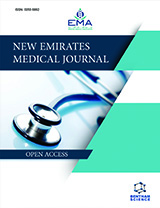Abstract
Background: Supraventricular tachycardia is the commonest type of narrow complex regular tachycardia seen in an emergency room, which can easily be diagnosed by surface ECG and acutely managed by Adenosine injection. A 59 years old male smoker was presented with palpitation with a pulse rate of 220/min with mild hemodynamic compromise. ECG confirmed narrow complex regular tachycardia, and the initial working diagnosis was established as Supraventricular Tachycardia (SVT) in the emergency room.
Case Presentation: As standard practice, adenosine was given, which failed in terminating the tachycardia but by creating a transient atrioventricular block, slowed down ventricular rate, and sawtooth-shaped P waves of atrial flutter were exposed. In contrast to the expectations, in this case of narrow complex regular tachycardia of supraventricular origin, adenosine could not establish the sinus rhythm but confirmed the diagnosis of atrial flutter with the regular rate with fixed A-V block.
Conclusion: Instead of therapeutic use, adenosine has been proven to be of diagnostic value, which can be used when the diagnosis of narrow complex tachycardia is in doubt, however with some cautions.
Keywords: Adenosine, Atrial flutter, Supraventricular tachycardia, Narrow complex tachycardia, Atrioventricular block, ECG.
New Emirates Medical Journal
Title:Diagnostic use of Adenosine for Atrial Flutter with Regular Tachycardia
Volume: 2
Author(s): Rajeev Lochan*, Deepaali Arora and Hussain Al Rahma
Affiliation:
- Department of Cardiology, Al-Zahra Hospital, Dubai,United Arab Emirates
Keywords: Adenosine, Atrial flutter, Supraventricular tachycardia, Narrow complex tachycardia, Atrioventricular block, ECG.
Abstract: Background: Supraventricular tachycardia is the commonest type of narrow complex regular tachycardia seen in an emergency room, which can easily be diagnosed by surface ECG and acutely managed by Adenosine injection. A 59 years old male smoker was presented with palpitation with a pulse rate of 220/min with mild hemodynamic compromise. ECG confirmed narrow complex regular tachycardia, and the initial working diagnosis was established as Supraventricular Tachycardia (SVT) in the emergency room.
Case Presentation: As standard practice, adenosine was given, which failed in terminating the tachycardia but by creating a transient atrioventricular block, slowed down ventricular rate, and sawtooth-shaped P waves of atrial flutter were exposed. In contrast to the expectations, in this case of narrow complex regular tachycardia of supraventricular origin, adenosine could not establish the sinus rhythm but confirmed the diagnosis of atrial flutter with the regular rate with fixed A-V block.
Conclusion: Instead of therapeutic use, adenosine has been proven to be of diagnostic value, which can be used when the diagnosis of narrow complex tachycardia is in doubt, however with some cautions.
Export Options
About this article
Cite this article as:
Lochan Rajeev *, Arora Deepaali and Al Rahma Hussain , Diagnostic use of Adenosine for Atrial Flutter with Regular Tachycardia, New Emirates Medical Journal 2021; 2 (2) . https://dx.doi.org/10.2174/0250688202666210520092352
| DOI https://dx.doi.org/10.2174/0250688202666210520092352 |
Print ISSN 0250-6882 |
| Publisher Name Bentham Science Publisher |
Online ISSN 0250-6882 |
 2
2
- Author Guidelines
- Graphical Abstracts
- Fabricating and Stating False Information
- Research Misconduct
- Post Publication Discussions and Corrections
- Publishing Ethics and Rectitude
- Increase Visibility of Your Article
- Archiving Policies
- Peer Review Workflow
- Order Your Article Before Print
- Promote Your Article
- Manuscript Transfer Facility
- Editorial Policies
- Allegations from Whistleblowers
Related Articles
-
Prevalence of Pre-Existing Risk Factors for Adverse Events Associated with Atypical Antipsychotics Among Commercially Insured and Medicaid Insured Patients Newly Initiating Atypical Antipsychotics
Current Drug Safety Microdialysis in Drug Discovery
Current Drug Discovery Technologies The Metabolism of Methazolamide - Identification of Metabolites in Guinea Pig Urine
Drug Metabolism Letters Anesthetic Considerations for Electroconvulsive Therapy-Especially Hemodynamic and Respiratory Management
Current Psychiatry Reviews Controlled Delivery of Biotechnological Products
Current Pharmaceutical Biotechnology An Overview of the Effect of Weight Loss on Cardiovascular Autonomic Function
Current Diabetes Reviews Vascular Inflammation in Hypertension: Targeting Lipid Mediators Unbalance and Nitrosative Stress
Current Hypertension Reviews A Paradigm Shift in the Development of Anti-Candida Drugs
Current Topics in Medicinal Chemistry Levosimendan for Heart-Operated Patients: What is the State of the Art?
Recent Patents on Cardiovascular Drug Discovery The Role of Protease-Activated Receptors for the Development of Myocarditis: Possible Therapeutic Implications
Current Pharmaceutical Design Pharmacological Approach of No-Reflow Phenomenon Related with Percutaneous Coronary Interventions
Cardiovascular & Hematological Agents in Medicinal Chemistry A Perspective on Clinical Islet Transplantation: Past, Present and Developments for Future
Immunology, Endocrine & Metabolic Agents in Medicinal Chemistry (Discontinued) ESVS Guidelines: Section B - Diagnosis and Investigation of Patients with Carotid Stenosis
Current Vascular Pharmacology Influence of Drugs on Mild Cognitive Impairment in Parkinson’s Disease: Evidence from the PACOS Study
Current Neuropharmacology Nitric Oxide and Cardiovascular Dysfunction in Sepsis
Endocrine, Metabolic & Immune Disorders - Drug Targets Recent Advances in Pulmonary Hypertension Therapy
Recent Patents on Cardiovascular Drug Discovery Infection and Hemodialysis Access: An Updated Review.
Infectious Disorders - Drug Targets COVID-19 Effects on Geriatric Population and Failures of Aminoquinoline Therapy: Compilation of Studies from EU, USA, and China; Safety and Efficacy of Vaccines in the Prevention and Treatment of COVID-19
Current Medicinal Chemistry Refractory Angina Pectoris: Lessons from the Past and Current Perspectives
Current Pharmaceutical Design Radiolabeled Probes Targeting Tyrosine-Kinase Receptors For Personalized Medicine
Current Pharmaceutical Design



























